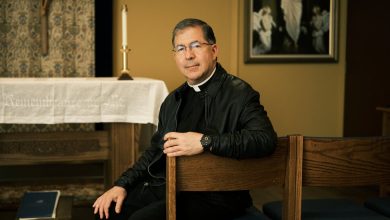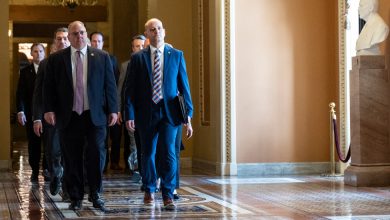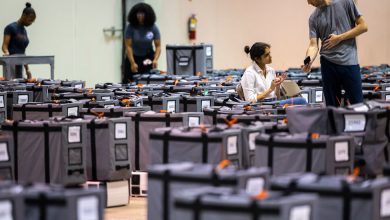Chicago Schools Reopen After a Stalemate

This is the Education Briefing, a weekly update on the most important news in U.S. education. .
Today, Chicago classrooms reopen as Los Angeles and other districts struggle to test students for the coronavirus. And a federal lawsuit accuses 16 top private colleges and universities of price-fixing on financial aid.

Most Chicago students returned to classrooms on Wednesday.Credit…Charles Rex Arbogast/Associated Press
Chicago opens; schools try tests
Chicago schools reopened today after the teachers’ union and the city struck a deal. Students are learning again for the first time since last Tuesday when the district canceled school after teachers voted to stop reporting to their classrooms.
City officials said the deal included provisions for additional testing, along with metrics that would close schools with major outbreaks.
Union leaders said the agreement was imperfect but necessary given the conditions teachers face during the pandemic.
And parents were frustrated, no matter where they fell on the reopening questions. They had to race to find child care and wrestle with the uncertainty.
“I feel like there’s a lot of political stuff going on,” Aaron Wise, who has two children in high school, said. “It’s hard, the situation is difficult. But it really shouldn’t be that difficult.”
But extensive testing may be tough to put into effect. Among the leading issues:
Rapid antigen tests are in limited supply.
The tests, which can be administered at home, are central to the test-to-stay strategy.
But supply chain issues and weather problems can worsen shortages. In California, for instance, storms over the winter break destroyed a million test kits that were meant for schools.
And tests can be faulty. In Florida this month, an attempt to supply tests to teachers in Broward County turned up expired kits.
Many districts have also chosen an opt-in approach.
That means they’re only testing a select group of students whose parents agree to have them tested — that is, those who may already come from more virus-conscious homes.
In Seattle, only about 14,000 of the district’s 50,000 students and 7,800 employees showed up when classes were canceled for testing.
Worryingly, about one in 25 tested positive. By Monday, two Seattle schools were closed from staff shortages and infections, and the district was contemplating a return to remote classes.
Parents may not understand how to use the tests.
Take Chicago. The district — the nation’s third-largest — sent out 150,000 or so mail-in P.C.R. tests over break.
Most were never returned. And of the 40,000 or so tests that were mailed in, most produced invalid results.
Lines can also be really, really long.
Parents may have to take time off work — time they may not have to spare.
In Seattle, some children waited for hours, some in a driving rain. Los Angeles families also lined up for blocks at school sites for much of last week to receive a swab.
Public health experts say few districts are testing enough, and strategically enough, particularly in the wake of Omicron.
District data from Los Angeles showed that during the week ending Monday, 66,000 tests out of about 458,000 tests had come back positive. That’s a positivity rate of more than 15 percent — lower than county, state and national averages, but still high enough to cause alarm.
“I’m worried, like a lot of parents,” Amanda Santos, whose 7-year-old attends first grade, said.
Despite the high positivity rate, Los Angeles, the second-largest district in the country, forged ahead with plans to open classrooms for in-person learning on Tuesday. Santos said she was reassured by the testing policy.
“They’re not letting anybody who has a positive test, or who doesn’t test, on campus,” she said. “So I feel secure about that.”
And tests can be expensive.
Since 2020, Los Angeles has had one of the nation’s most ambitious testing programs.
But the initiative — which encompasses more than 600,000 students and staffers — relies on P.C.R. tests provided for about $12 apiece by a start-up that is contractually obligated to provide overnight results.
The district’s cost per test is about half what the state negotiated for its tests with another vendor. But it’s still spending about $5 million per week on testing, the vice president of the school board said.
Are elite colleges fixing prices?
A new federal lawsuit is accusing 16 elite private colleges and universities — including M.I.T., the University of Chicago and many of the Ivy League schools — of conspiring to reduce financial aid through a price-fixing cartel.
The allegations hinge on a decades-old antitrust exemption, which permits these universities to collaborate on financial aid formulas — provided that they do not consider a student’s ability to pay in the admissions process. (You might know that as “need blind” admissions.)
The suit claims that nine of the schools are not actually need-blind because for many years, they have found ways to consider some applicants’ ability to pay. Because the schools collaborate in an organization called the 568 Presidents Group, the suit says, the actions of nine affect all 16.
The Coronavirus Pandemic: Key Things to Know
The latest Covid data in the U.S. As the Omicron surge causes case counts to reach record highs and hospitalizations to surpass last winter’s peak, here’s how to think about the data and what it’s beginning to show about Omicron’s potential toll and the growing gap in those vaccinated vs. unvaccinated.
Testing. In the absence of a national effort to make testing widely available, some big U.S. companies are putting their own testing services in place for their workers. Meanwhile, the White House promised to distribute millions of free tests to schools as many districts struggle with execution and resources.
Around the world. A spate of outbreaks in China weeks ahead of the Winter Olympics underscores the challenge of holding the Games while sticking to the country’s “zero Covid” policy. In Europe, the W.H.O. warned that over half the continent could be infected with Omicron in the next six to eight weeks.
Staying safe. Worried about spreading Covid? Keep yourself and others safe by following some basic guidance on when to test and how to use at-home virus tests (if you can find them). Here is what to do if you test positive for the coronavirus.
One claim: The University of Pennsylvania and Vanderbilt have considered the financial needs of wait-listed applicants.
Another claim: Other schools award “special treatment to the children of wealthy” donors, which, given the limited number of spots, hurts students needing financial aid.
And a conclusion: The suit claims that the colleges have overcharged an estimated 170,000 students who were eligible for financial aid over nearly two decades.
“Privileging the wealthy and disadvantaging the financially needy are inextricably linked,” the suit said. “They are two sides of the same coin.”
Virus news
Politics and unions
-
Politicized tensions over a return to remote learning — an effort often led by teachers’ unions — may snarl Democrats’ prospects in the midterms.
-
In The Atlantic, one parent explains why she’s turned away from the Democrats. “What I’ve lost is my trust that the party is truly motivated to act in the interests of those they claim to serve,” she writes.
-
A major teachers’ union in Rhode Island is calling for a statewide transition to remote learning.
-
Teachers in Denver have also called for a weeklong pause on in-person learning.
Staff shortages
Schools across the country are shifting to temporary remote learning as staff members report testing positive or needing to quarantine because of exposure.
-
Buses are not running for high school students in at least two North Carolina cities because so many drivers are out sick. In Durham, almost a third of drivers also did not work because they had not been paid.
-
Officials temporarily suspended bus routes for at least 20 public schools in Ann Arbor, Mich. And a suburb of Columbus, Ohio just held a transportation job fair in an effort to recruit more drivers.
-
Substitute teachers are in high demand across the country. One Texas district asked parents to fill in as substitute teachers.
-
A district in Minnesota is paying students $15 an hour to cover for janitor shortages.
What else we’re reading
Politics
-
The Republican candidate for education superintendent in South Carolina raised more than $125,000 in her first six weeks, The Associated Press reports, a record for this stage in the race.
-
Gov. Henry McMaster of South Carolina, a Republican, proposed a funding overhaul for public schools.
-
Gov. Brad Little of Idaho, a Republican, proposed an 11 percent budget increase for public schools.
-
Gov. Doug Ducey of Arizona, a Republican, said he wanted to limit the power of local school boards. The state is also squaring to argue over funding formulas.
-
The Kentucky Senate passed a bill to shift control of curriculum and principal selection to superintendents and away from councils.
-
Gov. Michelle Lujan Grisham of New Mexico, a Democrat, wants to increase the minimum pay for teachers, an effort to attract and maintain talent.
-
A good read: Far-right politics are taking root in school board races, The Washington Post reports.
Preschool
-
Democratic leaders in Colorado said they wanted to lay the groundwork for universal preschool education.
-
Gov. Andy Beshear of Kentucky, a Democrat, also proposed a large budget increase for education and called for state-funded preschool for every 4-year-old.
And the rest …
-
Arlington, Texas, refused to let a major energy company drill gas wells near a day care center.
-
A high school student in Connecticut died last week after he was severely hurt during a junior varsity ice hockey game.
-
At another high school in Connecticut, a coach was temporarily suspended after the basketball team beat an opponent 92-4. That approach, Sacred Heart Academy said, “does not align with our values or philosophies.”
-
And finally, some good news: A school in Vermont found an injured barred owl in November. It is now fully rehabilitated and returned to the woods this month.
Tip: Solve conflicts with Jenga
Henry García, a fifth-grade teacher at a 107th Street Elementary, a public school in South Central Los Angeles, uses Jenga to help his students talk about difficult issues.
“It very quickly gets very serious,” he said of the block-stacking game. “All of that makes it easy to get distracted and become very present in the game.”
Recently, he said, two of his students had a falling out. At one point, they both said they were done with their friendship, which had once been quite close.
“I thought: ‘How can I help heal this?’” he said.
So he brought out the Jenga. Their annoyance melted as the tower quivered. Soon, the two started laughing. The old friendship shone through their frustration.
“Once I realized they were having fun, that’s when I brought up the issue,” he said. “I asked, ‘Hey, what really happened?’”
Jenga, though, is just the first step. García tries to guide his students in their conversations, too. He helps them listen to one another and then reflect each other’s positions. At the end, he said, the students had reconciled.
“They were just so focused on the game and they didn’t want to lose, so they kind of let their guard down just enough to be in a space to talk a little bit more openly,” García said.
But he also said there was nothing special about Jenga — any game would do just fine. The important thing, he said, is to create “a more informal, less serious setting where we’re able to play, have fun — and also talk.”
That’s it for today’s briefing. If you have more classroom strategies to share, please email us at [email protected]. I’d love to share more teacher brilliance with you all in future newsletters. See you next week!
Sign up here to get the briefing by email.





